T-Cell-independent humoral immunity is sufficient for protection against fatal intracellular ehrlichia infection
- PMID: 17664264
- PMCID: PMC2044530
- DOI: 10.1128/IAI.00705-07
T-Cell-independent humoral immunity is sufficient for protection against fatal intracellular ehrlichia infection
Abstract
Although humoral immunity has been shown to contribute to host defense during intracellular bacterial infections, its role has generally been ancillary. Instead, CD4 T cells are often considered to play the dominant role in protective immunity via their production of type I cytokines. Our studies of highly pathogenic Ehrlichia bacteria isolated from Ixodes ovatus (IOE) reveal, however, that this paradigm is not always correct. Immunity to IOE infection can be induced by infection with a closely related weakly pathogenic ehrlichia, Ehrlichia muris. Type I cytokines (i.e., gamma interferon, tumor necrosis factor alpha, and interleukin-12) were not necessary for E. muris-induced immunity. In contrast, humoral immunity was essential, as shown by the fact that E. muris-infected B-cell-deficient mice were not protected from IOE challenge and because E. muris immunization was effective in CD4-, CD8-, and major histocompatibility complex (MHC) class II-deficient mice. Immunity was unlikely due to nonspecific inflammation, as prior infection with Listeria monocytogenes did not induce immunity to IOE. Antisera from both wild-type and MHC-II-deficient mice provided at least partial resistance to challenge infection, and protection could also be achieved following transfer of total, but not B-cell-depleted, splenocytes obtained from E. muris-immunized mice. The titers of class-switched antibodies in immunized CD4 T-cell- and MHC class II-deficient mice, although lower than those observed in immunized wild-type mice, were significant, indicating that E. muris can induce class switch recombination in the absence of classical T-cell-mediated help. These studies highlight a major protective role for classical T-cell-independent humoral immunity during an intracellular bacterial infection.
Figures
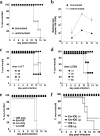
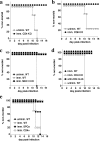
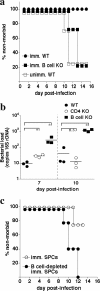
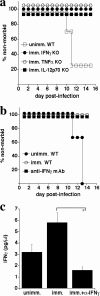
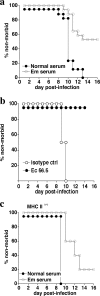

Similar articles
-
CD4 T-cell epitopes associated with protective immunity induced following vaccination of mice with an ehrlichial variable outer membrane protein.Infect Immun. 2007 Nov;75(11):5453-9. doi: 10.1128/IAI.00713-07. Epub 2007 Aug 13. Infect Immun. 2007. PMID: 17698576 Free PMC article.
-
Protective heterologous immunity against fatal ehrlichiosis and lack of protection following homologous challenge.Infect Immun. 2008 May;76(5):1920-30. doi: 10.1128/IAI.01293-07. Epub 2008 Feb 19. Infect Immun. 2008. PMID: 18285501 Free PMC article.
-
NK Cell-Mediated Regulation of Protective Memory Responses against Intracellular Ehrlichial Pathogens.PLoS One. 2016 Apr 19;11(4):e0153223. doi: 10.1371/journal.pone.0153223. eCollection 2016. PLoS One. 2016. PMID: 27092553 Free PMC article.
-
Immunity to the ehrlichiae: new tools and recent developments.Curr Opin Infect Dis. 2005 Jun;18(3):217-21. doi: 10.1097/01.qco.0000168381.86024.cf. Curr Opin Infect Dis. 2005. PMID: 15864098 Review.
-
Mechanisms of humoral immunity during Ehrlichia chaffeensis infection.Ann N Y Acad Sci. 2003 Jun;990:435-43. doi: 10.1111/j.1749-6632.2003.tb07408.x. Ann N Y Acad Sci. 2003. PMID: 12860671 Review.
Cited by
-
Antigen-driven induction of polyreactive IgM during intracellular bacterial infection.J Immunol. 2012 Aug 1;189(3):1440-7. doi: 10.4049/jimmunol.1200878. Epub 2012 Jun 22. J Immunol. 2012. PMID: 22730531 Free PMC article.
-
Detection of "Candidatus Neoehrlichia mikurensis" in two patients with severe febrile illnesses: evidence for a European sequence variant.J Clin Microbiol. 2010 Jul;48(7):2630-5. doi: 10.1128/JCM.00588-10. Epub 2010 Jun 2. J Clin Microbiol. 2010. PMID: 20519481 Free PMC article.
-
Infection-induced myelopoiesis during intracellular bacterial infection is critically dependent upon IFN-γ signaling.J Immunol. 2011 Jan 15;186(2):1032-43. doi: 10.4049/jimmunol.1001893. Epub 2010 Dec 13. J Immunol. 2011. PMID: 21149601 Free PMC article.
-
Anaplasma marginale infection with persistent high-load bacteremia induces a dysfunctional memory CD4+ T lymphocyte response but sustained high IgG titers.Clin Vaccine Immunol. 2010 Dec;17(12):1881-90. doi: 10.1128/CVI.00257-10. Epub 2010 Oct 13. Clin Vaccine Immunol. 2010. PMID: 20943884 Free PMC article.
-
T Cell-Independent Gamma Interferon and B Cells Cooperate To Prevent Mortality Associated with Disseminated Chlamydia muridarum Genital Tract Infection.Infect Immun. 2018 Jun 21;86(7):e00143-18. doi: 10.1128/IAI.00143-18. Print 2018 Jul. Infect Immun. 2018. PMID: 29661927 Free PMC article.
References
-
- Alugupalli, K. R., J. M. Leong, R. T. Woodland, M. Muramatsu, T. Honjo, and R. M. Gerstein. 2004. B1b lymphocytes confer T cell-independent long-lasting immunity. Immunity 21:379-390. - PubMed
-
- Belperron, A. A., C. M. Dailey, and L. K. Bockenstedt. 2005. Infection-induced marginal zone B cell production of Borrelia hermsii-specific antibody is impaired in the absence of CD1d. J. Immunol. 174:5681-5686. - PubMed
-
- Bendelac, A., O. Lantz, M. E. Quimby, J. W. Yewdell, J. R. Bennick, and R. R. Brutkiewicz. 1995. CD1 recognition by mouse NK1+ T lymphocytes. Science 268:863-865. - PubMed
-
- Bitsaktsis, C., J. Huntington, and G. M. Winslow. 2004. Production of interferon-γ by CD4 T cells is essential for resolving ehrlichia infection. J. Immunol. 172:6894-6901. - PubMed
-
- Bitsaktsis, C., and G. Winslow. 2006. Fatal recall responses mediated by CD8 T cells during intracellular bacteria infection. J. Immunol. 177:4644-4651. - PubMed
Publication types
MeSH terms
Substances
Grants and funding
LinkOut - more resources
Full Text Sources
Molecular Biology Databases
Research Materials

